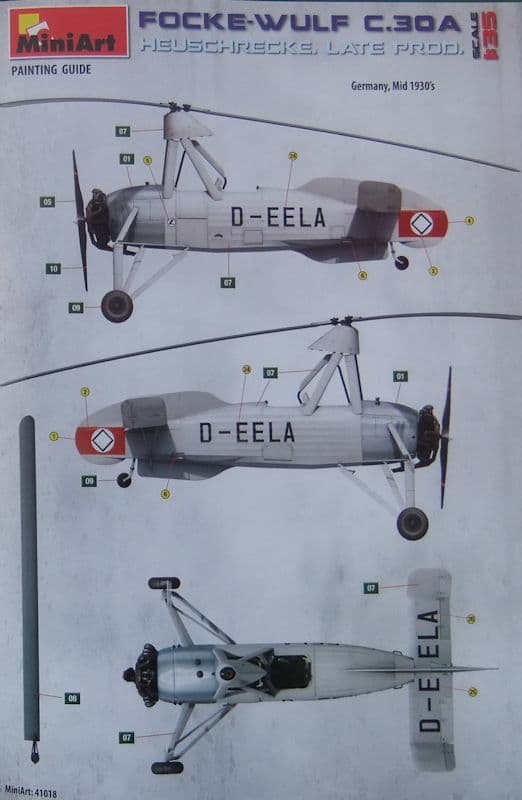Focke Wulf C30A Heuschrecke Late production Review
MiniArt | No. 41018 | 1:35
Prototype: The breakthrough in vertical flight by means of an aircraft is mainly due to the perseverance of the Spanish designer Juan de la Cierva. While hopes to build a helicopter previously ended in several failures of quite adventurous constructions, Cierva made his breakthrough in the early 1920s with the concept of the so-called autogyros. That means: A radial engine, conventional at the time, with a propeller, drove a system of rotor blades, called lifting screws, and was thus able to make take-off and landing from a standing start. In the forward flight, the rotors were kept rotating by means of the propeller and thus replaced the wings. The mother of all helicopters was also known as the gyroplane at that time. The Cierva C.30 went into production after a few setbacks and many countries, including England and Germany, applied for a license to build it.
Kit: It is a form variant of the Avro Rota Mk. I, here in the German variant of the Focke Wulf Heuschrecke. It seems to be slowly coming into fashion that more and more manufacturers of airplane models are finally dedicating themselves to the variety of types between the two world wars. This is an almost undiscovered country in our hobby. Thanks to Miniart, that such a model can be built in the optimal size for the little flier. And what manufacturing and detailing. 96 components made of plastic, burr-free, and filigree wait to be assembled.
There is also a circuit board with 40 brass parts. Above all, these complete the cockpit area, e.g. with the harness and the rotor blades.
The reproduction of the canvas structure of the two halves of the fuselage appears impressive. And the seven-cylinder radial engine from Siemens and the cockpit are models of their own. The cylinders are each made in one piece. They are then glued to the round inner core of the radial engine. In this way, the structure of the engine cylinder is retained because you don’t have to glue two halves of such parts together for manufacturing reasons, as is often the case. All of this should not overwhelm even a beginner, provided that he has the patience that filigree model making requires.
Focke Wulf C30A Heuschrecke Late production Paint
Painting: The small decal sheet also contains the Austrian state flag of the 1930s. There are also decals for the instrumentation in the cockpit.
Two German machines and one machine from Austria can be designed. These are presented in light gray on the canvas and natural aluminum in the area of the motor section. The detailed painting can be found in the very detailed assembly instructions.
Conclusion: A “grasshopper” is very welcome even in the apartment and in every showcase. However, it would be nice if a brief historical section of such models could be included in the instructions.













